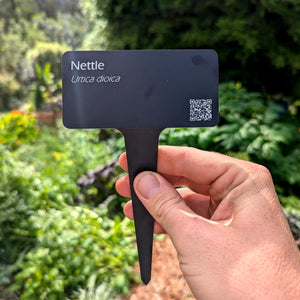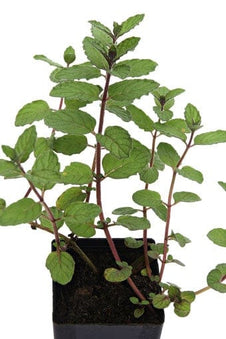
Mint - White Peppermint
Mint - White Peppermint

- In stock, ready to ship
- Inventory on the way

Usually available: All year
Life cycle: Perennial
Height: 30 - 90cm
Position: Sun / part shade
Soil preference: Moist / well drained
This is how we pack and send your Herb Plants to all states except TAS & WA
You will receive
- 1 White Peppermint Herb Plant in a 50 X 75mm tube - General growing instructions
All of our Herb Plants are grown organically with certified organic potting mixes and fertilizers
Botanical Name: Mentha piperita officinalis
White Peppermint is an evergreen perennial growing from 30-90 cm high, with a spreading habit. It has green leaves that end in a point and have serrated edges. The leaves are quite large at 4-9cm long and 1.5-4cm wide. The leaves a stems may be slightly fuzzy. The purple flowers are held in whorls and appear in summer. White Peppermint is very similar to Peppermint, however it lacks the red flush sometimes appearing on leaves and the red stems. Overall, the White Peppermint is a lighter shade of green and it has a milder taste than Peppermint.
Peppermint is native to Europe and was first described in 1753 by Linnaeus and thought to be a new species. However, it was later determined to be a hybrid from parents Mentha aquatica (Watermint) and Mentha spicata (Spearmint). It is still sometimes found in the wild near the parent plants. The preferred native habitat is moist soils near streams and natural drainage lines. White Peppermint is fast growing and is one of the main cultivated varieties of Peppermint.
Peppermint has one of the longest histories for use as a culinary and medicinal herb. It was also one of the earliest used herbs for commercial flavouring of confectionary, toothpaste, tea, ice cream and many other household products. Menthol, the active constituent in Peppermint, activates cold sensitive receptors on the skin and mucosal tissues creating the cooling sensation.
Please see Peppermint for further information.
Mint General
There are many Mint varieties known to herb gardeners and lovers of good cuisine, all varying slightly in flavour, aroma and appearance. They are categorized in the genus ‘Mentha’, which has up to 18 species, within the Lamiaceae family of plants. The Lamiaceae family is known as the mint family. However, the largest group of plants in the mint family is actually the delightful Salvias with their brilliantly coloured blooms. Many other commonly known herbs are also found in this family, including basil, sage, thyme and even lavender. One characteristic of this plant family is that they all yield essential oils, giving each plant its unique characteristics and even potential for medicinal use. Even the Scutellaria genus, with the unusually named Baikal Skullcap is found within this family.
The mints consist of mostly spreading and low growing perennial plants. The height range is from 10 cm to 1 meter, so not all are at ground level. Mint plants send out runners, or stolons, to help them spread by developing roots and shoots at the nodes. This allows plants to cover up to 1 meter in stem growth, in good conditions. They are all fast growing plants and due to the spreading nature, one plant is often sufficient for most gardeners. Some mints can be invasive and it is recommended that containers or in ground barriers be used. Mints can suffer from some pests like snails and aphids and may be affected by mint rust. Rust Free Mint may also be a useful addition to the garden in addition to the many other varieties.
Most mint plants have square stems, with leaves held in opposite pairs. They are often downy with a serrated margin, with a variable leaf shape and colours ranging from green to purple. The flowers are usually white to purple and present in false whorls or verticillaster or false whorl. The corolla is usually two lipped and has 4 lobes, with the upper lobe usually the largest.
Mint plants come from across the globe and will grow in most climates, including a wide range of regions across Australia. Some are annual varieties, but in cool climate zones perennial mints may best be treated as annuals and replaced each year. Generally they have high water requirements and prefer rich soils. Mint is grown commercially in Tasmania due to the ideal conditions of long summer days in high altitudes, where temperatures average 25C during the day to 15C at night. Ideal conditions usually require full sun, but part shade may be necessary as temperatures increase in warm summer regions.
Most mints have a history of traditional medicinal or herbal use for fevers, headaches and minor ailments. These plants are often used as a digestive aid in the form or herbal tea. The essential oil is also antiseptic and may be toxic in very high doses. They should be avoided by pregnant women and must not be given, or placed next to the face of babies and young children, due to the potential for breathing difficulties associated with menthol.
Mint hybridizes very easily, so there are many varieties available to suit any garden. In fact, if you have mixed plants some may hybridize in your own garden. The most popular choices are Spearmint, Peppermint and Applemint. However, many varieties in our collection, such as Ginger Mint, Eau de Cologne, Chocolate Mint and many others are also becoming well known.
Growing Conditions
Providing a moist garden position, with regular water during dry periods will ensure success. Like most mints, this variety will grow in part shade or full sun. Too much shade may result in a leggy plant as it reaches for the sun and a reduction in the essential oil content and flavour. But, Peppermint will grow almost anywhere and under most conditions. It is not frost tender. However, it has been listed as invasive in many regions including the USA, New Zealand and Australia. If spreading or garden escape might be a concern then container planting or using a garden barrier to stop roots spreading is advised. Propagation may be by cuttings or division since the roots will grow quickly and allow the plant to spread.
Culinary Uses
White Peppermint has similar culinary uses to Peppermint and other mint varieties. It may be used added to drinks, salads, desserts and cooked dishes.
Medicinal Uses
White Peppermint contains menthol and is similar to Peppermint, which has been used medicinally for centuries. Peppermint is commonly used for stomach complaints and as a digestive aid, due to its carminative properties. Research has indicated value in treating Irritable Bowel Syndrome with the active constituents found in Peppermint. Peppermint is also reputed to help focus and concentration and is the subject of significant medical research in an number of areas. Peppermint oil has not been approved for use in pregnancy and essential oils containing menthol should not be used near the face or hands of infants or toddlers.
All information provided on this website is for informational purposes only. Please seek professional advice before commencing any treatment.




